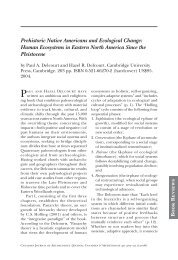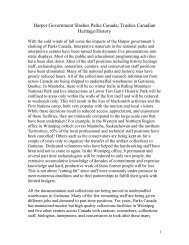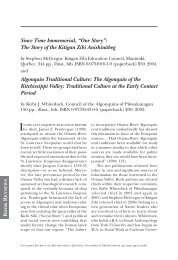culture associated with the Polar Inuit, we propose a different narrative of past hygienicpractices of Greenland’s Northwest coast.Duval, Isabelle (Université du Québec à Chicoutimi) Analyse <strong>de</strong> provenance sur ungorgerin avec la micro-XRF (31) Une caractérisation géochimique, <strong>de</strong> manière non<strong>de</strong>structive par micro-XRF, a été réalisée sur un fragment <strong>de</strong> gorgerin en pierre retrouvésur le site Cartier-Roberval (CeEu-4). Les données d’analyses ont permis d’associer lapierre du gorgerin avec une carrière <strong>de</strong> pierre décorative <strong>de</strong> grès rouge datant <strong>de</strong> la fin du19e siècle dans le Bas-Saint-Laurent. La compréhension du contexte géologique permet<strong>de</strong> suggérer <strong>de</strong>s lieux accessibles pouvant avoir été exploités à la préhistoire. Lesgorgerins sont <strong>de</strong>s objets polis rares qui apportent <strong>de</strong>s informations sur les habitu<strong>de</strong>sd’acquisition <strong>de</strong>s matières premières <strong>de</strong>s groupes autochtones. Des comparaisons ont étéfaites avec d’autres gorgerins du Québec et ceux fabriqués en ardoise rubanée.Provenance analysis with micro-XRF on a gorget stone. A geochemical characterizationwith a non-<strong>de</strong>structive micro-XRF analysis has been done on a stone gorget fragmentfound at the 16 th -century Cartier-Roberval site at Québec City (CeEu-4). Data analysishas linked the gorget stone with a Bas-Saint-Laurent red sandstone quarry that was usedfor <strong>de</strong>corative construction at the end of the 19 th century. Un<strong>de</strong>rstanding of the geologicalcontext allows us to suggest accessible places that may have been exploited at the precontacttime. Gorgets are rare polished objects that provi<strong>de</strong> information on Nativepatterns of raw material acquisition. Comparisons will be ma<strong>de</strong> with other gorgetsincluding those ma<strong>de</strong> of ban<strong>de</strong>d slate.Eid, Patrick (Université <strong>de</strong> Montréal) La recherche <strong>de</strong>s intentions et <strong>de</strong>s choixéconomiques à travers les chaînes opératoires lithiques (25) Il n’est certes pas nouveaud’abor<strong>de</strong>r l’étu<strong>de</strong> <strong>de</strong> la technologie lithique sous l’angle <strong>de</strong> l’économie. Dans la traditionanglo-saxonne, cette question a été principalement abordée via différents modèlesthéoriques. Or, aussi intéressants puissent-ils être, il <strong>de</strong>meure difficile <strong>de</strong> faire le pontentre un modèle généralisant et <strong>de</strong>s données archéologiques, surtout lorsqu’elles prennentla forme <strong>de</strong> milliers <strong>de</strong> petits morceaux <strong>de</strong> roche. Dans la tradition française, l’approchetechnologique abor<strong>de</strong> plutôt la question selon un angle inductif et empirique par larecherche <strong>de</strong>s intentions <strong>de</strong>s tailleurs et <strong>de</strong>s choix économiques perceptibles dans leurschaînes opératoires. L’application <strong>de</strong> cette approche à un échantillon <strong>de</strong> sites du Sylvicoledans la région du Témiscouata (Québec) servira <strong>de</strong> base pour étudier les apports et lesinconvénients <strong>de</strong> cette métho<strong>de</strong>. - The search of intentions and economic choices in lithicchaînes opératoires. The study of lithic technology from an economic viewpoint is notnew in itself. In the Anglo-Saxon tradition, this question has mostly been addressedthrough the use of theoretical mo<strong>de</strong>ls. As interesting as this approach can be, it remainsdifficult to fill the gap between a mo<strong>de</strong>l and the archaeological data, especially when theytake the form of thousands of pieces of rock. The French technological approach howeveraddresses this question with an inductive and empiric method, where the intentions an<strong>de</strong>conomic choices of individuals are rebuilt as chaînes opératoires. The application of thisapproach on a sample of archaeological sites from the Woodland period in SouthernQuébec (Témiscouata region) will be used to explore the contributions and disadvantagesof this method.
Ellis, Christopher (University of Western Ontario) The Davidson Site (AhHk-54) andLate Archaic Settlement Systems (23) This paper revisits one of Peter Rams<strong>de</strong>n’s earlyresearch interests, the seasonality of Archaic site occupations, through the lens ofDavidson, a 1.5 ha site near Parkhill, Ontario, intensively used from ca. 2500-800 BC. Ingeneral, Archaic research has been known for the “domination of theorizing and paucityof data” to quote one group of observers and since our analytical work is still very muchin its infancy, this research in some ways continues that trend. Nonetheless, preliminaryobservations allow us to actually assess some long-standing i<strong>de</strong>as about Archaicsettlement systems and suggests that while some conclusions seem correct, many otherassumptions we use to approach Late Archaic settlement systems in Ontario may bemisleading. Notably, we have used rigid and mechanistic mo<strong>de</strong>ls of these systemsgroun<strong>de</strong>d in adaptationist i<strong>de</strong>as. However, actual settlement and subsistence practices ofArchaic peoples seem to have been much more flexible and “messy” and cannot be aseasily explained solely in terms of environmental or least effort influences on behaviour.Fay, Amelia (Memorial University) Merging the Local and the Regional: FutureDirections for the archaeology of Inuit-European Contact in Labrador (3) The study ofInuit-European contact in Labrador presents the perfect opportunity for a combination ofanalytical approaches. Geographic and temporal scale are represented by the differentextent and timing of contact along the coast, the physical environment served to bothpermit and constrain human activities and mobility, and power and i<strong>de</strong>ntity are negotiatedthrough the spatial and material realms. ‘Contact’ in Labrador is difficult to <strong>de</strong>finebecause it occurred at different times throughout many places along the coast to variousextents. My archaeological exploration of Inuit-European contact in Labrador takes thisinto account by merging a local history from Nain within the broa<strong>de</strong>r coastal network.Ferris, Neal (Lawson Chair of <strong>Canadian</strong> Archaeology Western University/Museumof Ontario Archaeology) In Praise of Counter Factual Ontario Late Woodland CultureHistory (23) Peter’s contribution to what is commonly referred to as Ontario’s LateWoodland has been both profound and insignificant. Profound in that it has invitedimaginings, conceptions, and interpretations of the archaeological record from this periodas, in fact, an archaeological record inviting archaeologically-based theorizing of thatmaterial record; Insignificant in that many of his cohort in Ontario ignored as irrelevant anapproach that didn’t obviously and logically build cultural historical mo<strong>de</strong>ls of the ancientpast based on historically transitory socio-linguistic ethnicities. And so some if not mostof Peter’s writings on the subject was thus freed from interfering with the dominantcultural historical <strong>de</strong>bates of the day around what dialect pots or sites spoke, or howancient archaeological patterns were the result of early 17 th century historical events andobservations. Unfettered by that Ontario cultural historical logic, Peter’s musings haveretained an intellectual currency that invites imagining an archaeology of Ontario’s LateWoodland that is, well, of relevance to archaeology beyond those still wishing to conceiveof Ontario’s Late Woodland as a local history of how the early 17 th century came to be. Itis a relief to think that Ontario Late Woodland archaeology might just be increasinglyclose to catching up with Peter’s irrelevance.Ferris, Neal (The University of Western Ontario) Discussant (3)
- Page 1 and 2: RÉSUMÉS / ABSTRACTSPar ordre alph
- Page 3 and 4: glyphs in images for posterity have
- Page 5 and 6: Balac, Anne-Marie (Ministère de la
- Page 8: Bergeron, André (Centre de conserv
- Page 12 and 13: forme traditionnelle imprimée ou d
- Page 14: after learning about what happened
- Page 17 and 18: Cadieux, Nicolas, Jean-Christophe O
- Page 19: known in the area, both historic an
- Page 22 and 23: Comeau, Jennifer (Memorial Universi
- Page 24 and 25: in single households. Given that th
- Page 27 and 28: Crompton, Amanda (Memorial Universi
- Page 29 and 30: describe the spatial extent of the
- Page 31 and 32: Columbia. Although dogs are not a d
- Page 33 and 34: planification des fouilles archéol
- Page 35: synthèse des données biophysiques
- Page 39 and 40: ever made in an archaeological site
- Page 41 and 42: qui occupait déjà l’esprit des
- Page 43 and 44: impliqués dans les pêcheries et l
- Page 45 and 46: préhispaniques. Parmi ces camélid
- Page 47 and 48: archaeometrists these days is a tec
- Page 49 and 50: patches undertaken to identify the
- Page 51 and 52: integration of feature, artifact an
- Page 53 and 54: l’appellation crie désignant les
- Page 55 and 56: order to ensure there was no damage
- Page 57 and 58: in 1851 as a market and destroyed i
- Page 59 and 60: devait tenir compte des grands prin
- Page 61 and 62: elusive has been a consistent way o
- Page 63 and 64: driving forces in Québec archaeolo
- Page 65 and 66: Ly, Yvonne (Archéotec inc.) Essai
- Page 67 and 68: contribution de Google Earth à la
- Page 69 and 70: to its taphonomic agent. These obse
- Page 71 and 72: Monchot, Hervé (Université Paris
- Page 73 and 74: horticulturalists. Broad-bladed bif
- Page 75 and 76: Oetelaar, Gerald (University of Cal
- Page 77 and 78: Paxton-MacRae, Mark (Western Herita
- Page 79 and 80: 19 th and 20 th centuries. Old-grow
- Page 81 and 82: while deer, particularly white tail
- Page 83 and 84: Rankin, Lisa K. (Memorial Universit
- Page 85 and 86: Robinson IV, Francis (University at
- Page 87 and 88:
Royer, Martin (Ethnoscop inc.) Inve
- Page 89 and 90:
Sifontes, Sarah (York University) D
- Page 91 and 92:
isotopique par spectrométrie de ma
- Page 93 and 94:
quarries have been discovered and e
- Page 95 and 96:
aux XVII e et XVIII e siècles (25)
- Page 97 and 98:
last rapids of St. Laurence river.
- Page 99 and 100:
Woods, Audrey (Université de Montr
- Page 101 and 102:
theorizing material culture, much o








